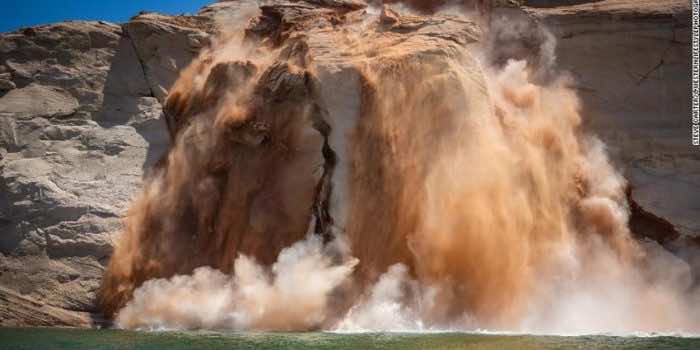Boaters hanging out on drought-stricken Lake Powell saw a dramatic sight on Memorial Day: a monumental section of canyon falling into the water. Boater Mila Carter posted to Instagram showed a massive chunk of a red canyon wall toppling over into the lake, releasing a cloud of dust, and sending columns of water in the air.
Carter told local outlet Fox 13, “It kind of didn’t stop and we could tell that more was coming, so we stopped and I kind of just pulled out my phone just in time,” she said.
The rockslide was “pretty incredible,” Carter said. “Saw something like I had never seen before…. I feel like the video didn’t do that big tidal wave justice. It was huge.”
Lake Powell has been a site of extreme events lately due to record low levels of water inside. On Thursday, the lake stood at 3,532 feet (1,076.6 meters) above sea level, according to readings provided by the U.S. Bureau of Reclamation. That’s a slight uptick from early last month when it sank to a record low of 3,522.7 feet (1,073.7 meters). But it’s still 29 feet (8.8 meters) lower than this same weekend in 2021 and almost 75 feet (22.8 meters) lower than Memorial Day weekend in 2020.
“The saturation and then drying with the falling water levels kind of contributed to that thing falling over,” Joe Cook, a research geologist with the Arizona Geological Survey, told KTVK of the Memorial Day collapse. “It might have fallen over anyway but having a reservoir there may have sped up the process.”
Cook added that it’s relatively rare occurrence for humans to see a slide, which he called a “rock topple,” like the one that Carter caught on camera.
“There’s probably a whole bunch of these things that are ready to go but they could happen in 100 years, 1,000 years,” Cook said. “We don’t really know.”
Officials have not released an official cause for the rockslide, and other experts pointed out that it’s difficult to determine specific causes for any one event.
“We see increased rockfalls during intense precipitation events and earthquakes, but apparently none of those conditions existed at the time of the rockfall in the video, so its trigger remains unknown,” Tyler Knudsen, a senior geologist with the Utah Geological Survey, told CNN. “Water-level decline certainly could have been the trigger, but, again, we can’t say for sure at this point. We do know that the creation of Lake Powell and its historical water-level fluctuations have contributed to elevated rockfall generation.
“Is it possible that some cliffs that are now being dewatered for the first time in over 40 years are generating more rockfalls? Yes, it’s possible,” Knudsen added. “Record low water levels are likely contributing to recent rockfalls along Lake Powell’s receding shores, but it’s difficult to definitively link a particular rockfall solely to declining water levels.”


